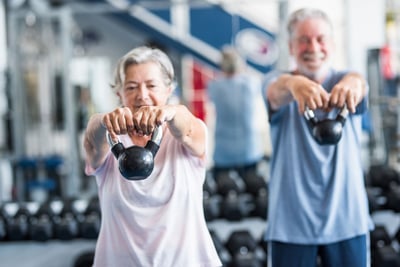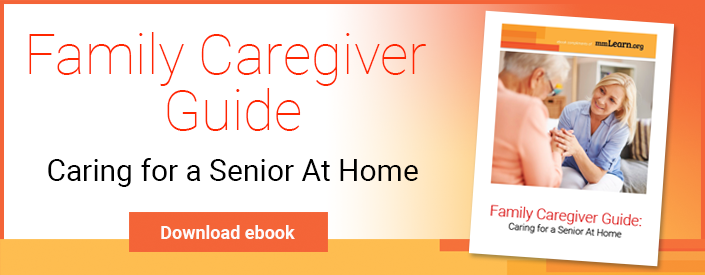 Many seniors and their caregivers are concerned about bone health—and for good reason.
Many seniors and their caregivers are concerned about bone health—and for good reason.
According to the Centers for Disease Control (CDC), more than 10 million people over the age of 50 had osteoporosis in 2010, and another 43 million had low bone mass.
What is osteoporosis? Who is at risk? And what can we do to prevent it?
Osteoporosis Basics
Bones are made up of living tissues that can be nourished through vitamins and strengthened by exercise.
People with low bone mass are at risk for developing osteoporosis.
Osteoporosis is a weakening of bone tissue, structure, and strength. People who have it may be at higher risk of fractures.
Fractures are a huge problem among older Americans. The National Osteoporosis Foundation commissioned a study that found that in 2016, approximately 1.8 million Medicare beneficiaries suffered 2.1 million osteoporotic fractures. Treating them costs billions. And you can’t put a dollar amount on the emotional and physical pain associated with fractures.
Osteoporosis is not an equal opportunity disease.
- One in two women will break a bone because of osteoporosis.
- Up to one in four men will experience a broken bone.
Fractures Are Dangerous but Preventable
One of the biggest risks, especially for older women, is hip fractures. The Bone Health Policy Institute shares the following statistics:
- Nearly 75,000 Americans die in the year following a hip fracture.
- Another 75,000 will move to a nursing home after a fracture.
- 150,000 do not regain the ability to walk across a room without assistance.
Clearly, we need to step up efforts to protect our elders from these dangerous accidents. There are many risk factors for osteoporosis that we can’t control: gender, age, size, ethnicity, and family history.
But the good news is that exercise is one of the best ways to strengthen and protect your bones.
Exercise for Strong Bones
The National Osteoporosis Foundation recommends two main kinds of exercise to help older people build bone strength and maintain bone density: weight‑bearing and muscle‑strengthening exercises.
1. Weight‑Bearing Exercises
Weight‑bearing exercises can be high‑impact or low‑impact. They are good for building bone density, which helps prevent osteoporosis. Most involve maintaining an upright position while putting weight on the musculoskeletal system. They include:
- High‑impact weight‑bearing exercises like running and jogging, jumping rope, hiking, stair climbing, tennis, racing, and aerobics
- Low‑impact weight‑bearing exercises like walking, elliptical machines and stair climbers, and low‑impact aerobics
2. Muscle‑Strengthening Exercises
Muscle‑strengthening training (or resistance or strength training) involves moving your body, handheld free weights, stability balls, or other types of equipment against gravity. It can include:
- Lifting free weights and using weight machines
- Functional movements and lifting your own body weight
- Using elastic exercise bands
- Yoga and Pilates
Both the American College of Sports Medicine (ACSM) and the American Heart Association recommend strength training for adults of all ages. Incorporated as part of an exercise plan, resistance training helps increase muscle strength, joint stability, and mobility while increasing overall bone health.
Note that bone strengthening exercise is not just for older people. It can be something to do together with a loved one.
The first step is consulting with a doctor to test for bone density and get recommendations for exercise.
Exercise for Your Aging Loved Ones
Many seniors are fearful of falling, so it is important to start slow and build confidence and strength. The National Osteoporosis Foundation recommends
- 30 minutes of weight‑bearing exercises on most days of the week
- 2‑3 days of weekly muscle‑strengthening exercises
- Daily balance, posture, and functional exercises. These can be done all at once or spread throughout the day.
Caregivers can help by exercising with their aging loved ones and encouraging them to get moving throughout the day. It doesn’t have to be big. Any amount of walking or simple posture and stretching exercise helps limber joints and strengthen bones.
This mmlearn physical therapy video gives tips on transitional movements and posture.
To learn more about osteoporosis and bone health, including training for the core, lower extremities, upper extremities, balance, and transitional movement and posture, mmLearn offers free online video resources for caregivers.
Healthy Bones for Healthy Seniors
It’s never too early, or too late, to make lifestyle choices that will increase bone density.
Some seniors are hesitant to begin exercise routines because they are afraid of hurting themselves, but the reality is that slowly increasing your activity to the level recommended by experts will protect against osteoporosis and fractures.
As caregivers, one of the best things we can do for our loved ones is to encourage them to make gradual lifestyle changes to protect their bones, especially if their goal is aging in place.
This blog post has been updated from its original version to include the most current information as of June 15, 2022.

